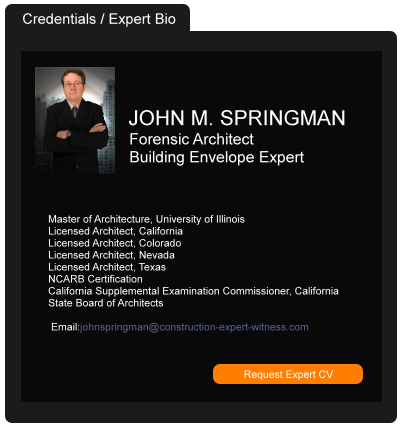Builders Association Seeks to Cut Down Grassroots Green Building Program (Guest Post)
October 04, 2021 —
Christopher G. Hill - Construction Law MusingsFor this week’s year end Guest Post Friday here at Musings, we welcome Michael Anschel. Michael is the owner of Otogawa-Anschel Design-Build, a member of BATC, lead the development of and serves as a board member to MN GreenStar, the CEO of Verified Green, Inc., and writes the green blog for Remodeling Magazine Online.
If you have been following the sad state of affairs in Minnesota recently (no not the elections) you might be scratching a bald spot on your head in amazement. To my knowledge it is the only state in which the local builders association [ www.batconline.org ] has actually sued the local Green building program (MN GreenStar [ www.mngreenstar.org ]; going as far as filing a restraining order to keep them from certifying any new homes in the state.
This is, in my opinion, a tragic move in the wrong direction for everyone; builders and homeowners alike.
The builders group widely know for The Parade of Homes claims to have no interest in using the program or the brand MN GreenStar, so why seek to shut the program down? Even the lawyers have been scratching their heads trying to make sense of this bizarre and highly aggressive move. And things just get more bizarre from there.
Read the court decisionRead the full story...Reprinted courtesy of
The Law Office of Christopher G. HillMr. Hill may be contacted at
chrisghill@constructionlawva.com
What You Need to Know About the Recently Enacted Infrastructure Bill
December 06, 2021 —
Garret Murai - California Construction Law BlogThis past week, President Biden signed the Infrastructure Investment and Jobs Act. The bill, commonly referred to as the Infrastructure Bill, provides for $1.2 trillion in spending over the next five years on the nation’s infrastructure and is one of two major legislative initiatives of the Biden Administration, the other being Biden’s $1.75 billion Build Back Better Bill focused on “soft” assets such money to fight climate change, for universal free preschool, for paid family and medical leave, etc.
While the Infrastructure Bill contains its fair share of pet projects, economists and historians generally agree that the Infrastructure Bill is the largest investment in the nation’s infrastructure since President Franklin D. Roosevelt’s “New Deal” in 1933.
Read the court decisionRead the full story...Reprinted courtesy of
Garret Murai, Nomos LLPMr. Murai may be contacted at
gmurai@nomosllp.com
Terminating Notice of Commencement Without Contractor’s Final Payment Affidavit
October 23, 2018 —
David Adelstein - Florida Construction Legal UpdatesPrior to construction work being performed on your property, a Notice of Commencement should be recorded. Among other things, construction liens will relate back in time to an effective Notice of Commencement (meaning it has not expired). For this reason, lenders or others will want the Notice of Commencement to be terminated when the job is complete by recording in the official records a Notice of Termination of the Notice of Commencement. There is a statutory procedure to terminate a Notice of Commencement pursuant to Florida Statute 713.132.
Frequently, a clerk will want the Notice of Termination of the Notice of Commencement to be accompanied with a Contractor’s Final Payment Affidavit because 713.132 says, in material part:
(2) An owner has the right to rely on a contractor’s affidavit given under s. 713.06(3)(d), except with respect to lienors who have already given notice, in connection with the execution, swearing to, and recording of a notice of termination. However, the notice of termination must be accompanied by the contractor’s affidavit.
Read the court decisionRead the full story...Reprinted courtesy of
David Adelstein, Kirwin NorrisMr. Adelstein may be contacted at
dma@kirwinnorris.com
Safeguarding the U.S. Construction Industry from Unfair Competition Abroad
November 07, 2022 —
Ric Macchiaroli - Gravel2Gavel Construction & Real Estate Law BlogIn April 2015, the U.S. International Trade Commission (ITC) issued an exclusion order prohibiting the importation of certain foreign-made crawler cranes into the United States for a period of at least 10 years. That order was the result of a 20-month investigation by the ITC, initiated by a Wisconsin-based crane manufacturer based on allegations of patent infringement and trade secret misappropriation by a China-based company. Defined by powerful injunctive remedies, unique rules, and a lightning-fast docket, the ITC can help protect American industry from unfair acts in the importation of articles into the United States. This post explores the traits that make the ITC an attractive venue for potential complainants.
ITC Site Plan
The ITC is a specialized trade court located in Washington, D.C., that has broad authority to investigate and remedy unfair trade practices. One of the ITC’s primary functions is to conduct unfair import investigations, also known as “section 337” investigations, after the authorizing statute. A section 337 investigation can be instituted based on any number of unfair acts, including, but not limited to, patent infringement (utility and design), registered and common law trademark infringement, copyright infringement (including violations of the Digital Millennium Copyright Act), trade dress infringement, and trade secret misappropriation. Business torts such as passing off, false advertising, and tortious interference with business relations have also formed the bases of investigations.
Read the court decisionRead the full story...Reprinted courtesy of
Ric Macchiaroli, PillsburyMr. Macchiaroli may be contacted at
ric.macchiaroli@pillsburylaw.com
Court Rules that Collapse Coverage for Damage Caused “Only By” Specified Perils Violates Efficient Proximate Cause Rule and is Unenforceable
January 26, 2016 —
Christopher Kendrick & Valerie A. Moore – Haight Brown & Bonesteel LLPIn Vardanyan v. Amco Ins. Co. (No. F069953, filed 12/11/15) a California appeals court held that policy wording that the collapse coverage for damage “caused only by” certain specified perils did not mean “solely” by those specified perils, but that coverage may nonetheless apply even if excluded causes contributed to the loss, under the Insurance Code section 530 and the efficient proximate cause rule.
In Vardanyan, the insured made a claim for water damage from unknown origin to a rental house. An engineer concluded that the various sources of moisture—roof leaks, gutters and downspouts that did not channel the water away from the house, a faucet spraying water on the exterior of the house, leaking toilet and bathtub, and humidity—contributed to the damage to the house, along with poor construction, termite damage and decay.
The insurer denied coverage citing multiple policy exclusions, including damage caused by seepage or leakage of water from a plumbing system; deterioration; mold, wet or dry rot; settling of foundations, walls or floors; earth movement; water damage; neglect; weather conditions; acts or decisions of any person; and faulty or defective design, workmanship, repair, construction, or maintenance. The insured retained a public adjuster who disagreed, in particular citing the policy’s “Other Coverage 9” coverage for collapse of a building or part of a building “caused only by one or more” of a list of perils, including hidden decay, hidden insect damage, and weight of contents, equipment, or people.
Reprinted courtesy of
Christopher Kendrick, Haight Brown & Bonesteel LLP and
Valerie A. Moore, Haight Brown & Bonesteel LLP
Mr. Kendrick may be contacted at ckendrick@hbblaw.com
Ms. Moore may be contacted at vmoore@hbblaw.com
Read the court decisionRead the full story...Reprinted courtesy of
Nobody Knows What Lies Beneath New York City
August 10, 2017 —
Greg Milner - BloombergBefore a single raindrop fell, Alan Leidner knew the waters could rise and throw the city into darkness. On this point, the maps were as clear as a crystal ball. All you had to do was look.
It was 2010, and Leidner was consulting for the government services company Booz Allen Hamilton Inc., contracted by the U.S. Department of Homeland Security to identify potential threats and vulnerabilities in the nation’s critical infrastructure. Leidner was examining a region that included New York and New Jersey. One day he was thinking about the area’s electrical power grid. He consulted some flood projection maps the Federal Emergency Management Agency had prepared. Then he stared at a map of the grid maintained by Consolidated Edison Inc., the region’s power supplier. And it just jumped out at him: The substation at East 13th Street, on the banks of the East River, was smack in the middle of a flood zone.
Leidner voiced his concerns with utilities, hospitals, and other major facilities. “The reaction was mostly, ‘Eh,’ ” he recalls, as we sit in the Tribeca offices of the Fund for the City of New York, where he directs the nonprofit organization’s Center for Geospatial Innovation.
Read the court decisionRead the full story...Reprinted courtesy of
Greg Milner, Bloomberg
Goldberg Segalla Welcomes William L. Nimick
February 07, 2022 —
Goldberg Segalla LLP(RALEIGH, N.C.)—Goldberg Segalla added William L. Nimick to the firm's Construction Litigation and Counsel group in Raleigh. Nimick was previously with The Law Offices of Stephen R. Paul in Raleigh.
Nimick is an experienced litigator who focuses his practice on counseling and defending corporate entities, insurers, contractors, and subcontractors in a range of liability claims, including those alleging construction defect, personal injury, property damage, premises liability, and more. Nimick draws on a background in civil litigation, personal injury and wrongful death, workers' compensation, and subrogation. He has handled subrogation claims across North Carolina, including construction defects, motor vehicle accidents, product liability lawsuits, and large fire losses.
Nimick earned his bachelor's degree at the University of North Carolina at Wilmington and his juris doctor at the Campbell University Norman Adrian Wiggins School of Law.
About Goldberg Segalla
Goldberg Segalla is a national civil litigation firm with more than 20 offices in 10 states spanning major metro markets across the U.S., providing strategic coverage wherever our clients do business. As a firm of experienced litigators and trial attorneys, Goldberg Segalla's capabilities span business and commercial disputes, employment and labor, insurance coverage, product liability, and more. Today, our more than 400 attorneys are trusted counselors to public and private clients in key sectors and industries including construction and energy, transportation, manufacturing, retail and hospitality, and insurance. To learn more, visit goldbergsegalla.com or follow us on
LinkedIn,
Facebook, and
Twitter.
Read the court decisionRead the full story...Reprinted courtesy of
How Small Mistakes Can Have Serious Consequences Under California's Contractor Licensing Laws.
February 15, 2018 —
Eric Reed - Myers, Widders, Gibson, Jones & Feingold, LLPIn construction, some risks have nothing to do with how well a contractor executes a project. Licensing problems is one of these risks. Even a brief lapse caused by an unintentional administrative error can give the CSLB grounds to discipline a contractor, or enable a customer to seek disgorgement and other remedies provided by Business and Professions Code section 7031. This article discusses five tips for mitigating the liabilities associated with licensing problems.
Tip 1: Take workers' compensation insurance very seriously. Workers’ compensation insurance problems can trigger license suspension in California. Business and Professions Code section 7125.4 calls for automatic suspension if a contractor cannot provide proof of workers’ compensation insurance for any period of time. This is particularly serious for residential remodelers who claim exemption for workers’ compensation but are later discovered – usually during litigation with a homeowner – to have “off the books” workers helping them. Courts can declare the contractor retroactively unlicensed under these circumstances and order it to disgorge,
i.e., to pay back, every penny paid by the customer for the entire project (even for materials). (Bus. & Prof. Code, § 7031, subd. (b);
Wright v. Issak (2007) 149 Cal.App.4th 1116.) The contractor will also find itself unable to collect any amounts owed to it by the customer. (Bus. & Prof. Code, § 7031, subd. (a).)
Tip 2: Watch out for licensing confusion after a merger or acquisition. The economic downturn of 2008 and 2009 resulted in consolidation throughout the building industry. The newly merged or acquired entities often allowed redundant licenses to expire, assuming they could complete all pending projects under the umbrella of the acquiring company's license. Many learned this was a mistake the hard way. Armed with the California Supreme Court's opinion in
MW Erectors, Inc. v. Niederhauser Ornamental & Metal Works Co., Inc. (2005) 36 Cal.4th 412, customers began refusing to pay invoices and demanding disgorgement under Business and Professions Code section 7031 because the original contractor did not maintain licensure “at all times.” Many of these customers succeeded.
Tip 3: If a license suspension has occurred or is imminent, prepare to prove substantial compliance. Section 7031(a) and (b) give a disgruntled or indebted customer every incentive to capitalize on a contractor's licensing problems. Subdivision (e) is where a contractor must turn to protect its interests if this happens. It allows the contractor to prove “substantial compliance” with licensing requirements and avoid (a)’s and (b)’s sharp edges if it can show the following:
(1) The contractor “had been duly licensed as a contractor in this state prior to the performance of the act or contract”;
(2) It “acted reasonably and in good faith to maintain proper licensure”; and
(3) It “acted promptly and in good faith to remedy the failure to comply with the licensure requirements upon learning of the failure.”
The Court of Appeal confirmed in
Judicial Council of California v. Jacobs Facilities, Inc. (2015) 239 Cal.App.4th 882 that a contractor, upon request, is entitled to a hearing on these three factors before it is subjected to disgorgement under Section 7031(b). The legislature amended Section 7031 shortly after the Court of Appeal published this case. The Assembly’s floor analysis went so far as to directly quote the opinion’s observation that penalizing a construction firm for “technical transgressions only indirectly serves the Contractors Law’s larger purpose of preventing the delivery of services by unqualified contractors.” (Assem. Com. on Bus. and Prof., Off. of Assem. Floor Analyses, analysis of Sen. Holden's No. 1793 (2015-2016 Reg. Sess.) as amended August 2, 2016, p. 2.) This echoed an industry consensus that clarifying the law was needed to ensure that properly licensed and law-abiding construction firms were not “placed at fatal monetary risk by malicious lawsuits motivated by personal gain rather than consumer protection.” (Assem. Com. on Judiciary, com. on Assem. Bill No. 1793 (2015-2016 Reg. Sess.), pp. 6-7.)
Unfortunately, existing law does not give many examples of what it means to act “reasonably and in good faith to maintain proper licensure” or to act “promptly and in good faith” to fix license problems. A practical approach is for a contractor to work backwards by assuming it will need to prove substantial compliance at some point in the future. Designated individuals within the organization should have clear responsibility over obtaining and renewing the proper licenses and should keep good records. If necessary, these designees can testify about the contractor's internal policies and their efforts to fix licensing problems when they arose. For example, if the suspension resulted from not providing the CSLB proof of workers’ compensation insurance, the designee can testify about the cause (a broker miscommunication, transmission error,
etc.) and produce documents showing how he or she worked promptly to procure a certificate of insurance to send CSLB. Saved letters, emails, and notes from telephone calls will provide designees and their successors with an important resource months or years down the line if a dispute arises and the contractor is required to reconstruct the chronology of a licensing glitch and prove its due diligence.
Tip 4: Don't sign new contracts unless all necessary licenses are active and any problems are resolved. A recently-formed contractor should not begin soliciting and signing contracts until all required licenses are confirmed as “active.” The first requirement of substantial compliance – being “duly licensed as a contractor in this state prior to the performance of the act or contract” – cannot be met by a contractor that first obtains its license mid-project. (Bus. & Prof. Code, § 7031, subd. (e)(1);
Alatriste v. Cesar’s Exterior Designs (2010) 183 Cal.App.4th 656.) A licensed contractor should also consider refraining from signing new contracts if there is any reason to believe its license might be suspended in the near future – especially if the suspension will be retroactive. Having a suspension on record at the time of contracting may complicate the question of whether the contractor was “duly licensed . . . prior to performance” for the purposes of substantial compliance.
Tip 5: Any judgment against a contractor can cause license suspension if not handled promptly and correctly. The Business and Professions Code authorizes the CSLB to suspend the license of a contractor that does not pay a construction related court judgment within 90 days. The term “construction related” is interpreted to include nearly all types of disputes involving a contractor. (16 Cal. Code Reg. 868;
Pacific Caisson & Shoring, Inc. v. Bernards Bros. Inc. (2015) 236 Cal.App.4th 1246, 1254-1255.) This means a contractor should treat a judgment against it for unpaid office rent, for example, as one carrying the same consequences as one arising from a construction defect or subcontractor claim. The contractor should also not assume that filing an appeal, or agreeing with the other side to stay enforcement, automatically excuses the 90-day deadline in the eyes of the CSLB. It does not. A contractor must notify the CSLB in writing before this period expires, then post bond for the amount of judgment, if it wishes to delay payment for any reason. (Bus. & Prof. Code, § 7071.17, subd. (d).) A suspension may result if it does not. This applies even to small claims judgments.
Recent case law and the 2016 amendments to Business and Professions Code section 7031 provide some solace to those caught in the dragnet of California's licensing laws. But avoiding these problems altogether is preferable. Consider licensing the foundation of a successful business and deserving of the same attention as the structures a contractor builds.
Eric R. Reed is a business and insurance litigator in the Ventura office of Myers, Widders, Gibson, Jones & Feingold, LLP.
Read the court decisionRead the full story...Reprinted courtesy of
Eric Reed, Myers, Widders, Gibson, Jones & Feingold, LLPMr. Reed may be contacted at
ereed@mwgjlaw.com


































































